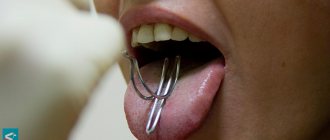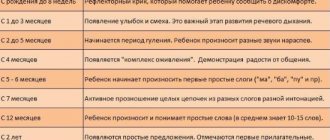Speech is divided into expressive (active) and impressive (passive). Normally, children master two types of it; it is the understanding of oral or written speech that is the passive form and precedes the emergence of active communication.
For example, with deafness it is present and is based on receiving information using the organ of vision. Blind people acquire written receptive language through tactile sensations. Impressive speech in children can be oral and written.
Speech activity consists of the perception of the sound composition of a word, its grammatical form, understanding of intonation and other means of language. It begins with the difference between someone else's and your own speech. This process occurs with the help of phonemic hearing. It is important to be able to distinguish between sounds, both hard and soft; apart from others and with continuous pronunciation. The formation of phonemic hearing ends completely at 4.5-5.5 years. Otherwise, we are talking about developmental delay.
Etiology and nature of deviation
The concepts of perception and understanding of speech are closely related. In the first case, this means how a person hears and reproduces individual sounds. However, he may not understand the meaning of what was said. For example, after reading an incomprehensible phrase, you will perceive it partially, and after clarifying the meaning of individual words, understanding will come. That is, in speech, perception through hearing or vision is primary.
Causes of impaired impressive speech:
- inversion (rearrangement of subjects and predicates in a sentence);
- inability to change the forms of words;
- failure to recognize speech sounds.
How speech understanding occurs at different periods of life can be seen from the table below.
| Skills and abilities | Child's age |
| The child is already responding to the voice of the parents | 1-1.5 months |
| Active reaction when addressed by adults (smile, waving arms, legs) | 3 months |
| Recognizes changes in intonation and responds accordingly | 4 months |
| When you contact him, there is a response hum | 5 months |
| Finds out his name | 6 months |
| Accepts requests accompanied by gestures | 7 months |
| Knows the names of the parts of the face | 7.5 months |
| Understands requests without reinforcement with gestures | 8.5 months |
| Can find already known objects in the room | 9-10 months |
| Begins to navigate using simple pictures in a book | 10-11 months |
| Knows the meaning of the word “cannot” | 11 months |
| Understands phrases like: “come”, “let’s go eat.” Can show at least two colors. | 1 year |
| Answers questions in picture books | 2 years |
| Accepts short stories and fairy tales. The baby can understand the characteristics of familiar objects, the meaning of the words hurt, loud, etc. | 2 years 5 months |
| Get to know antonyms | 3 g |
| Maintains dialogue by answering questions | 3 years 5 months |
| Perceives speech in a generally accepted form, phrases with 10 or more words | 4 years 5-6 months |
| Can answer questions: what is friendship or fear, joy | 5-6 years |
Another sign of speech perception in speech therapy is orientation in a fast paced conversation and analysis of information. Pauses help with this, but at a fast pace new words can be formed due to the merging of phonemes. In written speech, an important point is the relationship between words and the change in their forms in phrases. If the case is incorrect, it is impossible to understand the meaning of the phrase. An oral means of impressive speech is intonation. Naturally, sentences with homogeneous members and participial phrases are more difficult to perceive.
Advice to parents: while the child’s passive speech is not fully formed, use short and understandable phrases of 7-8 words for communication. Prohibitions or praise should also be concise.
Stages of formation and development of speech
When a person develops speech function, it is necessary to distinguish between the development of sensory speech
(i.e., understanding it) and
expressive speech
(i.e., the ability to speak), moreover, the ability to understand speech appears in a child already in the second half of life, and the ability to speak only in the second year of life. In other words, even before the child begins to speak, he already understands the meaning of words.
Sensory speech is associated with the cortical projections of the visual, auditory and skin analyzers, as well as with the speech understanding center described by the German psychiatrist and neurologist K. Wernicke, located in the posterior third of the superior temporal gyrus (Wernicke's center).
Expressive speech depends critically on the area of the cerebral cortex described by the French anthropologist and surgeon P. Broca. It is located in the posterior third of the inferior frontal gyrus (Broca's area, or expressive speech center). The functioning of this center is causally determined both by the information received from the received speech signal and by internal incentives and motivation.
The development of expressive speech occurs parallel to the development of sensory speech, and the process of children mastering speech as a means of communication during the first years of life goes through several stages.
At the first (preverbal) stage,
covering the first half of life, the child does not yet understand the speech of those around him and does not know how to speak himself, but conditions gradually develop here that ensure the mastery of speech in the future. The child does not react to the word, that is, not to the meaning of what is said, since in this complex of stimuli it is only a sound stimulus for him. The reaction occurs to the strength of sound, intonation, timbre of the voice, a set of parallel stimuli (the sight of a familiar person, for example, a mother, her smell, energy aura, etc.), and, as a rule, ends with a motor act. It is clear that the success of “passing” this stage of speech learning depends, first of all, on the state of the child’s sensory systems and, above all, auditory and visual.
At the second stage
–
the emergence of speech
– a transition occurs from the complete absence of speech to its appearance. This stage serves as a transitional stage between two eras in the child’s communication with people around him - preverbal and verbal. Despite this intermediate position, it is extended in time and usually covers about a year - from the second half of the first to the second half of the second year of life, and in the case of delayed speech development, it can last up to a year and a half. The main content of the second stage consists of two events: understanding of the speech of surrounding adults arises and the first verbalizations appear - the period of babbling, or syllable-by-syllable speech.
Third stage
–
development of speech (language) communication
– covers all subsequent time, up to 7 years, when the child masters the language and uses it more and more perfectly and diversely to communicate with people around him. This stage is closely related to the development and improvement of the second signaling system.
At the age of one and a half to 3 years, a child masters not only pronouncing words, but also significantly expands his vocabulary; by the age of 5, he simultaneously masters the lexical and grammatical structure of speech, develops normative sound pronunciation, coordination mechanisms between breathing, phonation and articulation, which ensures sufficient smoothness of speech utterance. By the age of 5-6, the child also begins to develop the ability for sound analysis and synthesis, which allows him, with normal development, to move on to a new stage - mastering writing and written speech.
This period is the most favorable for learning a language (before this, children of all nationalities “walk” in exactly the same way). The child masters the language spoken by those around him, regardless of his nationality. This is the primary (maternal) way of learning language, and it is based on the first signaling system according to a very simple scheme: sensory image → word.
The secondary method, used mainly for learning foreign languages, is based on knowledge of the “native” language. The scheme for acquiring a new language here becomes much more complicated: sensory image → word in the native language → word in a foreign language
. Teaching this way not only to adults, but also to children, is much less effective.
There are three critical periods in the development of speech function, when the most intensive development of certain parts of the speech system occurs, and therefore there is an increased vulnerability of the nervous mechanisms of speech activity and the risk of disturbances in its function even when exposed to minor exogenous hazards. In these cases, a critical period in the development of speech is a predisposing condition for the occurrence of speech disorders, and can have either independent significance or be combined with other unfavorable factors - genetic, general weakness of the child, dysfunction of the nervous system, etc.
First period
– 1st–2nd years of life – the prerequisites for speech are formed and speech development begins, the foundations of communicative behavior are formed and the need for communication becomes their driving force. At this age, the most intensive development of cortical speech zones occurs, in particular Broca’s area, the critical period of which is the child’s age of 14–18 months.
Second period
– 3 years – coherent speech develops intensively and a transition from situational speech to contextual speech occurs, which requires great consistency in the work of the central nervous system (speech motor mechanism, perception, attention, memory, etc.). A certain discrepancy that arises in the work of the central nervous system, neuroendocrine and vascular regulation, leads to a change in the child’s behavior - stubbornness, negativism, etc. are observed. All this determines the greater vulnerability of the speech system. Stuttering, mutism, and delayed speech development may occur. The child refuses verbal communication, and a reaction of protest appears to the excessive demands of adults on him. Stuttering that often occurs at this stage may also be due to age-related unevenness in the maturation of individual parts of the speech functional system and various mental functions.
Third period –
6–7 years – the beginning of the development of written speech. The load on the child’s central nervous system increases, associated with mastering the coordination skills of writing and its visual control, and therefore the importance of the functional state of the tactile and visual analyzers increases. When increased demands are placed on a child, he may experience “disruptions” in his nervous activity, in particular, with the appearance of stuttering.
Analysis of the behavior of young children shows that nothing in their life and behavior determines the urgent need to use speech. Only the presence of an adult who constantly addresses the child with verbal statements and demands an adequate response to them, including speech (“What is this?”; “Answer!”; “Name it!”; “Repeat!”), forces him to master speech . Voice interaction is a type of situational-personal communication, and if a child is not presented with vocal sound as a carrier of communicative information, he does not independently discover the possibilities that are hidden in this sound for adequate communication. Therefore, if a child, due to special circumstances, finds himself outside the human environment ("Mau-gli" children), or does not hear the speech of adults at an early age (for example, in families of the deaf-mute), he does not develop his own speech, even if hearing not violated. It is also known that when the norm of “audible speech” falls below a certain limit, a state of speech sensory deprivation (restriction, deprivation) arises, which inhibits the verbal development of children.
Consequently, only in individual communication with an adult does a child face a special kind of communicative task - to understand the adult’s speech addressed to him and to utter a verbal response. If an adult does not provide for a verbal response and does not insist on it, then in children a gap forms between the level of development of passive and active speech, with the latter lagging behind. It has been proven that speech underdevelopment is most often observed in children who are raised outside the family: in orphanages, children's homes, preschool institutions with 24-hour stay. At a time when a child needs communication with loved ones, he is deprived of such an opportunity. The communicative factor influences the development of speech in children at all three stages of its formation.
Many researchers believe that speech that is sonically monotonous, not colored with vivid emotions, and not directly addressed to the child also has a negative impact on verbal development.
Thus, the conditions for the formation of normal speech include a preserved central nervous system, the presence of normal hearing and vision, and a sufficient level of active verbal communication between adults and the child.
4.2.The role of hearing in speech development
Human speech arose and developed on the basis of the auditory system: the development of the ability to pronounce sounds is associated with the development of the ability to perceive them. A person would not be able to achieve such a level of mastery of the vocal apparatus if the hearing organs did not develop in parallel with this. Hearing is so important for speech that in its absence, for example, deafness or hearing loss, a person becomes mute. Deaf-muteness, in turn, leads to mental retardation, various communication difficulties, and personality changes. Even in ancient Greece, deaf and hard of hearing people were prohibited from holding leadership positions.
The role of auditory perception is very great in the development of cognitive activity, in enriching a person’s imagination and ideas about the world around him. But hearing also has a more specific “speech” purpose: with its help, a child has the opportunity to expand his vocabulary, develop oral speech, and make the necessary phonemic adjustments to it. Therefore, even a slight hearing loss can lead to the development of pronunciation defects and disruption of the grammatical structure of speech.
The auditory analyzer begins to function from the first hours of a child’s life. The child's first reaction to sound is dilation of the pupils, holding his breath, and some movements. Then the child begins to listen to the voice of adults and respond to it; in the second half of life - to perceive certain sound combinations and associate them with certain objects or actions; at the age of 7–9 months. – imitate the speech sounds of others. By the age of one year he begins to speak his first words.
Children who are deaf from birth do not develop imitation of the speech of others. Their babbling appears in the same way as in normally hearing children. But it does not receive reinforcement from auditory perception and therefore gradually fades away. In such cases, without special pedagogical influence, children’s speech does not develop.
Gradually, the activity of the auditory and speech motor analyzers becomes more complicated. During the process of phylogenesis, human hearing acquired a special property: to accurately distinguish the sounds of human speech (phonemes). This differs from the hearing of animals. The phonemic sound system, used in different types of speech activity to distinguish the meanings of words, is formed in a child at the age of 2-5 under the control of hearing. The development of phonemic awareness occurs gradually, in parallel with the formation of pronunciation. Usually, by the age of 4, a child masters the ability to distinguish all phonemes of his native language by ear.
However, in early childhood, the child perceives the sounds, syllables and words of those around him unclearly and distortedly. Therefore, children often mix one phoneme with another and poorly understand speech. Very often, children do not notice their incorrect pronunciation, so it becomes habitual, persistent and subsequently overcome with great difficulty. A child’s speech is correctly formed only when the development of the second signal and phonemic systems is constantly controlled by an adult.
Hearing loss that occurs before the process of speech development begins, or at its very beginning, leads, as a rule, to a general underdevelopment of speech, when the pronunciation of sounds begins to be disrupted (for example: to wash - muvanti
), mixing sounds according to sonority - deafness, softness - hardness (for example:
butterfly - daddy
).
Other speech development disorders in the deaf and hard of hearing include:
– repeated incorrect pronunciation of words, with correct pronunciation once;
- violation of the lexico-grammatical structure of speech - individual members of the sentence are missed, violations of morphological norms, errors in the use of various parts of the word are allowed;
- poor vocabulary, leading to difficulty understanding the text being read due to the fact that children often do not understand the meaning of individual words;
– difficult mastering the skills of using adverbs, conjunctions and, especially, complex and complex sentences expressing target, cause-and-effect and other logical dependencies. This turns out to be difficult for children and adolescents not so much because of the complexity of lexical and grammatical dependencies, but because of an insufficient understanding of the content of sentences, the lack of formation of their verbal-logical conceptual thinking, since concrete conceptual thinking prevails in them.
If a child has hearing impairment, there is a decrease in the ability to receive, process, store and use information:
– difficulty of verbal mediation;
– slowing down the process of concept formation.
Delayed speech development in children with hearing impairments affects not so much a narrowing of the volume of their vocabulary, but rather the uniqueness of the use and understanding of the meanings of words. The worse a child hears, the worse he speaks; the earlier the hearing loss occurred, the more severe the speech disorder; The sooner measures are taken to preserve or cultivate normal speech, the better the child’s speech is preserved.
The role of vision in speech development
The visual system takes a very small part in the development of speech functions in a child, since blind children and blind adults are guided by acoustic channels of speech information, sometimes by tactile ones (Braille for the blind). Difficulties arise during the transition to those types of speech that are focused on the active work of the visual analyzer associated with mastering reading and writing skills.
On the other hand, it is an established fact that children blind from birth, even with normal hearing, begin to speak much later. This is due to the development of speech imitation (echolalia),
which begins in the second half of the child’s first year of life. A sighted child, fixing his gaze on the face of the speaker, begins to close and open his mouth, move his lips, imitates exaggerated articulatory movements well, then begins to repeat sounds, and then whole words. Echolalia can be well expressed already in the second year of a child’s life. Reflexes of imitation and repetition remain strong even at 5-6 years old, and therefore, at this age it is recommended to start learning a foreign language.
The formation of speech in sighted people and people with visual impairments is carried out in fundamentally the same way, however, the absence of vision or its profound impairment changes the interaction of analyzers, due to which a restructuring of connections occurs, and during its formation, speech is included in a different system of connections than in sighted people.
Blindness and profound visual impairment cause deviations in all types of cognitive activity. The amount of information received is reduced. The role of hearing, touch (feeling objects when perceiving them) and other analyzers is increasing in the life and activities of the blind and visually impaired. Qualitative changes occur in the system of relationships between analyzers, specific features arise in the process of forming images, concepts, speech, orientation in space, etc.
Significant changes occur in the physical development of the child: the accuracy of movements is impaired, their intensity decreases, while the development of the motor analyzer and active motor mode are powerful stimulators of speech function, since the mechanism of speech reproduction is associated with the complex coordinated work of speech centers with the motor areas of the cortex.
The speech of the blind and visually impaired develops in the course of interpersonal communication, but has its own formation characteristics - the pace of development changes, the vocabulary and semantic side of speech is disrupted, and “formalism” appears.
Disruption of the activity of the visual analyzer leads to the formation of new intra- and interanalyzer connections, to changes in relationships within the sensory system and the formation of a specific psychological system characteristic only of the blind and visually impaired, with its own characteristics of perception, thinking, memory, emotions, etc.
Our thinking consists of establishing relationships between perceptions and concepts (inferences). It is logical, therefore, to imagine that if perception suffers when vision is impaired, then inferences must also suffer. However, most authors directly or indirectly point to the lack of correlation between the level of development of thinking and memory and impaired visual acuity, recognizing, however, their slow development.
Speech as the basis of thinking
Speech is included very early in the process of a child’s mental development. In children of the first years of life, speech has an important influence on the development of sensations and perceptions, and contributes to the formation of thinking. In an adult, speech, one way or another, is involved in all of his mental processes, cognitive activity, thinking, memory, etc.
It is known that children with speech disorders may have slower intellectual development. Researchers claim that speech disorders (including general speech underdevelopment) are much more common in children with mental retardation or mental retardation than in children with normal intelligence. Consequently, the central nervous system plays a huge role in the child’s speech development.
On the other hand, a child with general speech underdevelopment often exhibits deviations in the development of his mental functions: a slowdown in the rate of mental development, gnostic thought processes, abnormal development of the emotional-volitional sphere, character, and sometimes the personality as a whole. Therefore, it is customary to consider speech impairment in close unity with the characteristics of the child’s mental development.
In 1982, the English scientist R. Sperry was awarded the Nobel Prize for research that showed that the left hemisphere cortex is responsible for verbal operations and speech. This should be understood as the fact that the left hemisphere structures provide the most important - analytical and abstract-logical - components of the speech function. The left hemisphere is responsible for understanding speech, performing movements and gestures related to language, mathematical calculations, and interpreting symbolic concepts. As the lexico-grammatical side of speech develops, the child masters such intellectual operations as comparison, analysis and synthesis, which underlie abstract thinking.
The right hemisphere cortex controls the performance of non-verbal functions. It controls the interpretation of visual images, spatial relationships, and recognition of objects, but does not allow it to be expressed in words. In addition, the right hemisphere determines the perception of music.
This relationship between the functions of the right and left hemispheres is formed in a child after four years of age, but, despite the pronounced difference in functions, the right and left hemispheres of a healthy person are in constant interaction. There are powerful associative connections between them, so perception, speech and thinking are always the result of their joint activity.
The development of a child’s thinking takes place on two levels – directly on the active plane, and on the speech plane. Both of these plans, of course, interact and interpenetrate each other. The development of thinking in an effective way, more and more intelligent handling of things, is both a prerequisite and a result of the development of verbal thinking; conditioning the development of verbal thinking, the child’s increasingly intelligent practical activity, in turn, develops under its influence. At the same time, however, the primary thought processes are undoubtedly carried out as subordinate components of some “practical” (in a child - play) external activity, and only then thinking is singled out as a special, relatively independent verbalized “theoretical” cognitive activity.
Speech pathology
General underdevelopment of speech is understood as a form of speech pathology in which the formation of each of the components of the speech system is disrupted: vocabulary, grammatical structure, sound pronunciation,
with normal hearing and relatively intact intelligence. A systemic disorder of speech activity has typical manifestations: late appearance of expressive speech, a sharply limited vocabulary, pronounced agrammatism, defects in pronunciation and phoneme formation, specific violations of the syllabic structure of words, undeveloped coherent speech, thus reflecting the unity of pathological manifestations in all three of these components speech system.
Etiological (causal) factors causing speech disorders are complex and polymorphic. Among the causes of speech disorders, there are biological
and
social
risk factors.
that are biological in nature have a certain significance in the etiology of speech disorders in children .
Often they are predisposing conditions that develop into speech pathology under the influence of some adverse influences.
However, in some cases, hereditary factors also act as leading causes of speech pathology, for example, a family history
of speech disorders (left-handedness and right-handedness). The most common combination of hereditary predisposition, unfavorable environment and disruption of the normal maturation and functioning of the central nervous system.
Hereditary factors in the occurrence of speech disorders usually act in combination with exogenous-organic and social factors.
Under exogenous-organic factors
understand the various adverse effects (brain hypoxia, infections, trauma, intoxication, etc.) on the child’s central nervous system and on his body as a whole.
Depending on the time of their exposure, intrauterine ( prenatal)
), during childbirth (
initial
) and after birth (
postnatal
) pathology.
Intrauterine pathology is often combined with damage to the child’s nervous system during childbirth and in the first days after birth ( perinatal
pathology).
The consequences of exposure to unfavorable factors can be organic central
(when the brain is affected) and
organic peripheral
(if the morphological development of the peripheral speech apparatus is disrupted).
Perinatal pathology (embryopathies) can be caused by viral diseases of the mother during pregnancy, taking medications, ionizing radiation, vibration, alcoholism and smoking during pregnancy, some bacterial infections, toxicosis, as well as a variety of obstetric pathologies (narrow pelvis, prolonged or rapid labor , premature rupture of amniotic fluid, umbilical cord entanglement, malpresentation of the fetus, etc.). Obstetric manipulations during childbirth (application of obstetric forceps, vacuum extractor, etc.) are also important, which can damage the fetal nervous system.
| Rice. 23. Prognathia | Rice. 24. Progenia | Rice. 25. Anterior open bite | Rice. 26. Lateral open bite |
In children with developing anomalies and malformations of the brain, asymmetries of the skull, anomalies of the palate (high “Gothic” palate, flattened palate, nonunion of the palate and lip), developmental defects or underdevelopment of the lower and upper jaws, leading to malocclusions (progeny) are often observed. , prognathia, anterior or lateral open bite - Fig. 23-26), deviations in the structure of the dentition (sparse teeth, absence of certain teeth, deformed edges of teeth, etc.). An example of speech disorders resulting from a congenital cleft palate is open rhinolalia;
all defects in the development of the jaws, the structure and location of the teeth are accompanied by pronunciation disorders, most often in the form of
a lisp
(sigmatism).
Birth trauma and asphyxia (oxygen starvation) of the fetus at the time of birth can lead to intracranial hemorrhages and death of nerve cells from “suffocation.” These cell lesions can also affect the speech areas of the cerebral cortex, which entails the development of alalia.
Alcoholic embryopathic syndrome is described, including retardation of physical, speech and mental development, craniofacial deformities, and the role of chronic alcoholism in its origin is shown. Delayed speech development is directly related to concomitant hearing impairment in the child.
Pathological effects in the late stages of pregnancy usually do not cause severe congenital malformations, but lead to a delay in the maturation of the nervous system, disruption of the myelination of its structures, and often manifest themselves subsequently as difficulties in speech production of central-cortical origin.
Speech disorders can also arise as a result of the influence of various unfavorable factors on the child’s brain at subsequent stages of its development. The structure of these speech disorders varies depending on the time of exposure to harmfulness and the location of brain damage. A special role is played by early organic brain lesions, combined with unfavorable conditions of upbringing and environment of the child in the first years of his life.
Socio-psychological risk factors
associated mainly with the mental deprivation of children. Of particular importance is emotional deprivation - the lack of emotionally positive contact and verbal communication between a child and adults. A negative impact on speech development can also be caused by the need for a child of primary preschool age to simultaneously master two language systems, excessive stimulation of speech development, an inadequate type of education, and pedagogical neglect. As a result of the influence of these reasons, the child may experience developmental disorders in various aspects of speech.
Functional speech disorders also include those associated with adverse general effects on the child’s body: general physical weakness; immaturity caused by prematurity or intrauterine pathology; diseases of internal organs; rickets; metabolic disorders, etc., because any general or neuropsychic disease of a child, especially in the first years of life, is usually accompanied by a violation of speech development.
Hence, it is legitimate to distinguish between speech formation defects
and
defects in formed speech,
considering three years of age as their conditional rubicon.
The essence of the abnormal development of a child with hearing, vision or speech impairment is that the biological root cause (sensory or speech defect) determines a violation of the child’s social status, with an atypical formation of his psyche, which ultimately manifests itself in functional disorders - underdevelopment speech, features of thinking, attention, memory, perceptions, ideas, etc.
Inferior speech activity leaves an imprint on the formation of children's sensory, intellectual and affective-volitional spheres.
There is insufficient stability of attention and limited possibilities for its distribution.
While semantic and logical memory is relatively intact,
children
have reduced verbal memory and
memorization productivity suffers. They lag behind in the development of verbal and logical thinking; without special training they have difficulty mastering analysis and synthesis, comparison and generalization.
L I T E R A T U R A
1. Ananyev B. G.
Sensory-perceptual organization of man // On the problems of modern human science. – M., 1977.
2. Baido E. S.
Anatomy, physiology and pathology of the organ of vision: Textbook. – Veliky Novgorod, 2001. – 85 p.
3. Dubrovinskaya N.V., Farber D.A., Bezrukikh M.M.
Psychophysiology of the child: Psychophysiological foundations of children's valeology: A textbook for students of higher educational institutions. – M., 2000.
4. Ermakov V. P., Yakunin G. A.
Fundamentals of typhlopedagogy: Development, training and education of children with visual impairments: A textbook for universities. – M.: GITS VLADOS, 2000. – 238 p.
5. Karpova S. N., Truve E. I.
Psychology of child speech development. – Rostov-on-Don, 1987.
6. Kovalevsky E. I.
Ophthalmology: Textbook for medical universities. – M.: MEDICINE, 1995. – 480 p.
7. Kolesov D.V., Mash R.D., Belyaev I.N.
Biology. Human. – M., 2002.
8. Speech therapy: Textbook for universities / Ed. L. S. Volkova. – M., 2004.
9. Luria A. R., Yudovich F. A.
Speech and the development of a child’s mental processes. – M., 1956.
10. Neiman L. V., Bogomilsky M. R.
Anatomy, physiology and pathology of the organs of hearing and speech: Textbook for universities. – M.: GITS VLADOS, 2001. – 224 p.
11. Fundamentals of speech therapy / Ed. T. B. Filicheva, N. A. Cheveleva, G. V. Chirkina. – M.: ENLIGHTENMENT, 1989.
12. Handbook of speech therapist / Ed. M. A. Povalieva. – Rostov-on-Don: PHOENIX, 2002.
13. Hearing loss / Ed. N. A. Preobrazhensky. – M., 1978.
14. Reader on speech therapy / Ed. L. S. Volkova. – M.: VLADOS, 1997.
Consequences of the disorder
Impressive speech goes through several stages in its development: from perceiving someone else’s speech to composing one’s own statements. To understand phrases, you need to know the grammatical basis of the word and its meaning.
Stages of development of receptive speech:
- I – understanding the intonation of adults;
- II – assessment of the situation in repeated conditions;
- III – the child names objects, events and actions;
- IV – final, in which the baby fulfills the requests of adults.
Receptive speech disorders cause a delay in the development of expressive speech. General underdevelopment of speech (GSD) leads to phonemic and grammatical problems and poor vocabulary. There is also a decrease in intelligence and weakness of character. Against the background of pathological processes, muscle tone weakens, static coordination and endurance deteriorate. Preschool children are characterized by clumsiness, clumsiness, lack of facial expressions, and poor coordination of movements.
The patient is unable to distinguish sounds, resulting in speech that is crumpled and inarticulate. For mild disorders, it is possible to replace sounds with similar ones, which is called literal paraphasia. They check this by quickly reading it out loud, this significantly increases the number of reservations. In the case of a severe course, a person is generally unable to understand what is being said to him.
In the course of his research, V.P. Glukhov revealed inertia, rapid depletion of combinatorial functions, and poor spatial imagination in children with ODD. When involved in the game process, their observation, motivation and self-control are reduced. Due to lack of self-confidence, they are withdrawn, aggressive, and touchy, which makes it difficult for them to adapt to society. The most difficult thing for them is to perceive information visually due to attention and memory disorders.
Conditions for organizing receptive speech:
- ability to recognize sounds;
- understanding words and meaning of phrases;
- the formation of communication skills and vocabulary through imitation and exclamation;
- teaching word semantics and grammar;
- teaching a child dialogue.
Autistic children often do not pay attention to the intonation properties of speech. So, if his parents reproach him for his misdeed, “Well, you did well!”, he will consider these words as praise and will continue to perform this action.








